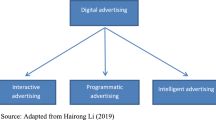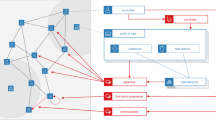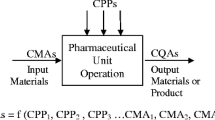Abstract
Providers of so-called packaged-retail and insurance-based investment products (PRIIPs) in the European Union have to draw up a standardized key information document (KID) since 1st of January 2018. In addition to some standard information on the product and its provider, this key information document discloses the product’s riskiness by means of a summary risk indicator, its performance potential by means of performance scenarios and its costs by means of a detailed disclosure of charges including a summary cost indicator. For products with multiple investment options, the regulation requires product providers to disclose a range for the summary cost indicator for the available investment options in the product. For feasibility, in practice often only synthetic investment options instead of the whole available investment portfolio are considered to derive an estimate for the required range. Based on a standard approach used in the German and Austrian insurance market, we analyze those investment options which actually yield the lower and especially upper bound of the required range. By considering different unit-linked products with investment guarantees our results show that those synthetic investment options typically used in practice may provide a false estimation of the range and, in particular, significantly underestimate the real upper bound. Further, we provide guidance how the “worst-case” combination of the investment option’s volatility and its charges can be found such that the summary cost indicator is maximized for the different products considered here.




Similar content being viewed by others
Notes
Note, in an ideal world, product providers would compute the required numbers for each available investment option and then derive the corresponding ranges from that. However, in practice often (due to the required simulations for the products considered) these derivations are only performed for some limited number of “synthetic” funds assumed to yield the “least and most expensive” investment option.
[7] treats the derivation of the summary risk indicator, especially for regular premium products, in more detail.
The reduction in yield and the amount of charges shall be disclosed assuming an investment horizon equal to the recommended holding period. In addition, the cost figures shall also be disclosed after a period of 1 year and at halftime of the recommended holding period.
In Germany, for a product to qualify as a state-subsidized product it has to be certified in advance. Part of this certification process is the derivation of a risk-return class. This derivation is done by an organization called “Produktinformationsstelle Altersvorsorge”.
The following (risk-neutral) specifications closely follow [3].
The parameters used in our analysis (cf. Sect. 5, Table 2) yield the corresponding spot rate in percentage points. Therefore, an additional adjustment with \(\frac{1}{100}\) has to be performed.
Calibrated parameters by the German Federal Reserve bank may be found via https://www.bundesbank.de/dynamic/action/de/statistiken/zeitreihen-datenbanken/zeitreihen-datenbank/759778/759778?statisticType=BBK_ITS&listId=www_skms_it03c&treeAnchor=GELD (last checked: June 2020).
Note, [12] in contrast to [13] sets \(P^{M} \left( {0,t} \right) = \left( {1 + z\left( {0,t} \right)} \right)^{ - t}\) as compared to \(P^{M} \left( {0,t} \right) = { \exp }\left( { - z\left( {0,t} \right)t} \right)\). Hence, for the parameters to be consistent we follow [12] for the definition of \(P^{M} \left( {0,t} \right)\).
Note, [6] also requires disclosure of the reduction in yield and the total amount of charges for interim investment periods after 1 year and after the contract’s halftime. We will focus on the recommended holding period only, but our results also transform to earlier time points.
By the variation of constants formula, a solution of the differential equation \(f^{\prime}\left( t \right) = g\left( t \right)f\left( t \right) + h\left( t \right)\) is given by \(f\left( t \right) = e^{{\mathop \smallint \limits_{0}^{t} g\left( s \right)ds}} \left( {\mathop \smallint \limits_{0}^{t} \left( {h\left( s \right)e^{{ - \mathop \smallint \limits_{0}^{s} g\left( u \right)du}} } \right)ds + c_{0} } \right), c_{0} \in {\mathbb{R}}\)
Note, the initial charge \(\beta\) at time \(t = 0\) will be accounted for separately and hence is not contained in \(C_{0}\) here.
For ease of notation, the critical candidate \(\sigma_{A}^{{ \star }}\) will be referred to the “worst-case volatility” in the remainder of this paper.
“Prudent” in this sense means that combining the worst-case volatility \(\sigma_{A}^{{ \star }}\) and the lowest available charge \(c_{A}\) yields the highest disclosure of \(RIY\) and \(C\) for the presumably cheapest fund in terms of its charge \(c_{A}\).
In practice some parts of the fund’s charges \(c_{A}\) or an additional guarantee fee would be used to finance some hedge portfolio such that this hedge will deliver \(\left( {G_{T} - A_{T} } \right)^{ + }\) at maturity and hence the guaranteed payment would not be “for free”.
References
AVÖ (2018) Leitfaden zum Österreichischen Branchenstandard für PRIIPs der Kategorie 4. https://avoe.at/wp-content/uploads/2018/11/Leitfaden-AV%C3%96-Branchenstandard-PRIIP-Kategorie-4-11_2018-final.pdf. Accessed 28 Nov 2018
Balder S, Brandl M, Mahayni A (2009) Effectiveness of CPPI strategies under discrete-time trading. J Econ Dyn Control 33(1):204–220
Brigo D, Mercurio F (2006) Interest rate models—theory and practice. Springer, Berlin
DAV (2018) Ein Standardverfahren für PRIIP der Kategorie 4. Internally available from the German Actuarial Association, downloaded on 13th of September 2018
European Commission (2014) REGULATION (EU) No 1286/2014 OF THE EUROPEAN PARLIAMENT AND OF THE COUNCIL of 26 November 2014 on key information documents for packaged retail and insurance-based investment products (PRIIPs). http://eur-lex.europa.eu/legal-content/EN/TXT/?qid=1490733841056&uri=CELEX:32014R1286. Accessed Oct 2019
European Commission (2017) COMMISSION DELEGATED REGULATION (EU)…/… of 8.3.2017 supplementing Regulation (EU) No 1286/2014 of the European Parliament and of the Council on key information documents for packaged retail and insurance based investment products (PRIIPs) by laying down regulatory technical standards with regard to the presentation, content, review and revision of key information documents and the conditions for fulfilling the requirement to provide such documents AND corresponding annexes. http://ec.europa.eu/finance/docs/level-2-measures/priips-delegated-regulation-2017-1473_en.pdf and http://ec.europa.eu/finance/docs/level-2-measures/priips-delegated-regulation-2017-1473-annex_en.pdf. Accessed Oct 2019
Graf S (2019) PRIIP-KID: providing retail investors with inappropriate product information? Eur Actuar J. https://doi.org/10.1007/s13385-019-00191-4(Forthcoming)
Graf S, Korn R (2020) A guide to Monte Carlo simulation concepts for assessment of risk-return profiles for regulatory purposes. Eur Actuar J. https://doi.org/10.1007/s13385-020-00232-3
Korn R, Wagner A (2018) Chance-risk classification of pension products: scientific concepts and challenges. Innovations in insurance, risk- and asset management. pp 381–398
Niemeyer A, Rieck T (2018) German market standard for PRIIP category 4 products. Talk at the international conference of actuaries (ICA) in Berlin
Produktinformationstelle Altersvorsorge (2017) Basismodell der Kapitalmarktsimulation. http://www.produktinformationsstelle.de/assets/PIA-Kapitalmarktmodell-Basisprozesse-2017.pdf. Accessed 12 May 2017
Schich ST (1997) Schätzung der deutschen Zinsstrukturkurve. Diskussionspapier 4/97. Volkswirtschaftliche Forschungsgruppe der- Deutschen Bundesbank
Svensson LEO (1994) Estimating and interpreting forward interest rates: Sweden 1992–1994. NBER Working Paper Series, Working Paper No. 4871
Author information
Authors and Affiliations
Corresponding author
Additional information
Publisher's Note
Springer Nature remains neutral with regard to jurisdictional claims in published maps and institutional affiliations.
Rights and permissions
About this article
Cite this article
Graf, S., Kling, A. PRIIP-KID: appearances are deceiving or why to expect the unexpected in a generic KID for multiple option products. Eur. Actuar. J. 10, 527–555 (2020). https://doi.org/10.1007/s13385-020-00243-0
Received:
Revised:
Accepted:
Published:
Issue Date:
DOI: https://doi.org/10.1007/s13385-020-00243-0




